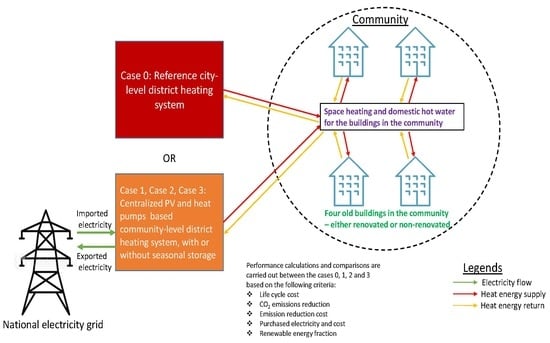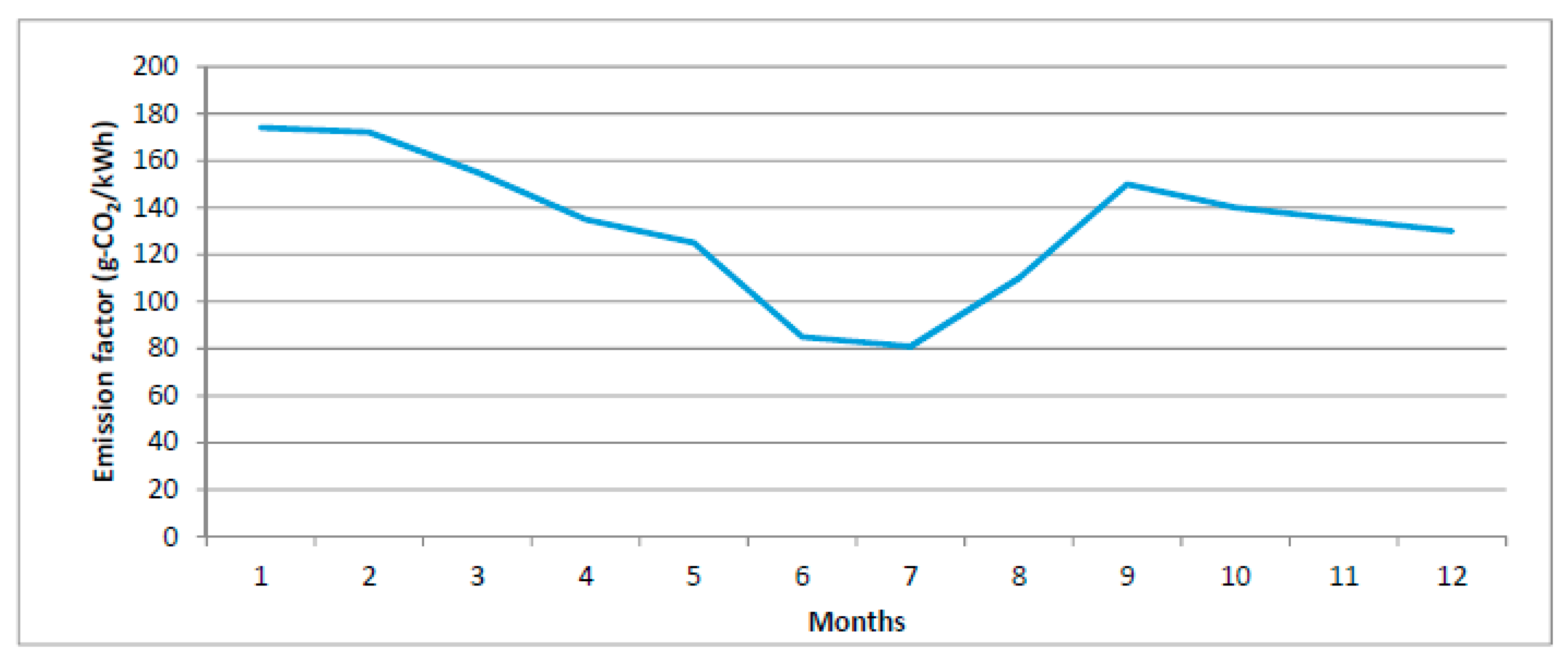EU Emission Targets of 2050: Costs and CO2 Emissions Comparison of Three Different Solar and Heat Pump-Based Community-Level District Heating Systems in Nordic Conditions
Abstract
1. Introduction
2. Methodology
2.1. Simulation Method and Framework
2.2. Building Description
2.3. Energy System Description and Simulation Method
2.3.1. Reference Case: City-Level District Heating
2.3.2. Centralized PV and GSHP-Based District Heating System
2.3.3. Centralized PV and Air-Water Heat Pump (A2WHP)-Based District Heating System
2.3.4. Centralized PV and Heat Pump (HP)-Based District Heating System with Seasonal Storage
2.4. Simulation of Energy Systems
2.5. Energy and Life Cycle Cost (LCC) Calculations
2.5.1. Design Variables and Costs
2.6. Emissions
2.7. Renewable Energy Fraction
3. Results and Discussion
- Case 0: Reference city-level district heating system.
- Case 1: Centralized PV and GSHP-based community-level district heating system (PV + GSHP).
- Case 2: Centralized PV and A2WHP-based community-level district heating system (PV + A2WHP).
- Case 3: Centralized PV and heat pump-based community-level district heating system with seasonal storage (PV + A2W + GSHP + STR).
3.1. Reference Case 0: City-Level District Heating
3.2. Case 1: Centralized PV and GSHP-Based District Heating System
3.3. Case 2: Centralized PV and A2WHP-Based District Heating System
3.4. Case 3: Centralized PV and HP-Based District Heating System with Seasonal Storage
3.5. Comparison of the Emissions and Costs between the Energy Systems
- First, in the reference city-level district heating system (Case 0), by investing only in the renovation of the original reference building (OR) in order to reach the deep renovated (DR) building level, the CO2 emissions were reduced by 53%. These emissions can be reduced by only investing at the building level, with no investment on the centralized renewable-based district heating system for the community.
- Second, in the reference district heating system (Case 0) in the OR building scenario, the purchased energy cost was significant, with an overall 77% of the life cycle cost. This can be reduced to 34% when the centralized solar PV + A2W + GSHP + STR-based district heating system (Case 3) is connected with similar OR buildings in the community. Moreover, the purchased energy cost can be further reduced to 11% when the centralized solar PV + A2W + GSHP + STR-based district heating system (case 3) is used with deep renovated (DR) buildings in the community.
- Third, when the OR or DR types of old buildings are used in the district, the emissions can be reduced significantly by investing in the centralized renewable-based district heating systems (Cases 1, 2, and 3). However, the share in the investments are different depending on the building types (i.e., if the buildings are OR type, the investment share on the buildings is low, however, the imported energy costs are high. On the other hand, when the DR type of building forms the community with centralized renewable-based district heating systems (Cases 1, 2, and 3), the share of the building level costs are high, however, the imported energy costs are reduced significantly when compared to the OR type of the buildings in the community.
- Fourth, the emissions reduction cost varied from 2.48 €/kg CO2/yr to 8.21 €/kg CO2/yr, depending on the centralized energy system case. Overall, the cost changed by 82% for the total investments in order to reduce a kilogram of CO2 emissions from the heating network of old buildings in the community.
- Finally, compared to the reference district heating system (Case 0) integrated with OR old buildings in the community, the emissions can be reduced by 91% when the centralized PV + heat pump-based district heating system with seasonal storage (Case 3) is used along with the deep renovated (DR) old buildings in the community. This would change the share or percentage of investments at the building level and the centralized energy system.
4. Conclusions
- Generally, the three proposed centralized community-level district heating systems (Cases 1, 2, and 3) outperformed the reference city-level district heating system (Case 0) integrated with the old apartment buildings in terms of emissions, purchased energy, and renewable energy fraction in the Nordic climate.
- The centralized PV-based district heating system with seasonal storage (Case 3) performed better in terms of emissions, technical performance, and renewable energy fraction compared to the centralized PV and GSHP-based district heating system (Case 1) and also compared to the centralized PV and A2WHP-based district heating system (Case 2). However, the LCC increased for Case 3 compared to Cases 1 and 2.
- The centralized PV and HP-based district heating system with seasonal storage (Case 3) was able to reduce the emissions from the original reference (OR) buildings in the community from 34 kg CO2/m2/yr to 5.7 kg CO2/m2/yr when the reference city-level district heating system (Case 0) was changed. Moreover, this change reduced the relative emissions by 83% and the emissions reduction cost was 3.74 €/kg CO2/yr. The results show that the utilization of seasonal storage can have a positive impact in emissions reduction from the district heating.
- The centralized PV and HPs-based district heating system with seasonal storage (Case 3) is able to reduce the emissions from the deep renovated (DR) buildings in the community from 16 kg CO2/m2/yr to 3.1 kg CO2/m2/yr when the reference city-level district heating system (Case 0) was changed. Moreover, this change reduced the relative emissions by 80% and the emissions reduction cost was 8.21 €/kg CO2/yr.
- When original buildings (OR) connected with the city-level district heating system (Case 0) was deep renovated (DR) and the city-level district heating system (Case 0) was replaced by the best community-level energy system (Case 3), the emissions were reduced from 34 kg CO2/m2/yr to 3.1 kg CO2/m2/yr. As a result, the relative emissions were reduced by 91% and the emissions reduction cost was 11.9 €/kg CO2/yr. This shows that in some cases, it can be expensive to reduce a kilogram of CO2 emissions. Certainly, high investment cases resulted in better techno-economic performance (i.e., reduced purchase electricity, imported energy cost, and CO2 emissions).
- In terms of the renewable energy fraction for heating, the centralized PV and HP-based district heating system with seasonal storage (Case 3) was able to reach 80% when integrated with the deep renovated (DR) building community. On the other hand, the renewable energy fraction for heating was around 50% with the other proposed community-level energy systems (Cases 1 and 2).
Author Contributions
Funding
Acknowledgments
Conflicts of Interest
References
- European Commission. 2030 Climate & Energy Framework. 2018. Available online: https://ec.europa.eu/clima/policies/strategies/2030_en (accessed on 1 April 2020).
- European Commission. 2050 Long-Term Strategy. 2018. Available online: https://ec.europa.eu/clima/policies/strategies/2050_en (accessed on 2 December 2019).
- Rehman, H.U. Techno-Economic Performance of Community Sized Solar Heating Systems in Nordic Conditions; Aalto University; Aalto-yliopisto: Helsinki, Finland, 2018. [Google Scholar]
- European Parliament. “Directive 2010/31/EU of the European Parliament and of the Council on the Energy Performance of Buildings,” 2010. Available online: https://eur-lex.europa.eu/LexUriServ/LexUriServ.do?uri=OJ:L:2010:153:0013:0035:en:PDF (accessed on 2 July 2019).
- Moore, T.; Horne, R.; Morrissey, J. Zero emission housing: Policy development in Australia and comparisons with the EU, UK, USA and California. Environ. Innov. Soc. Transit. 2014, 11, 25–45. [Google Scholar] [CrossRef]
- Statistics Finland. “Energy Supply and Consumption,” 2018. Available online: http://tilastokeskus.fi/til/ehk/2018/04/ehk_2018_04_2019-03-28_tie_001_en.html (accessed on 10 July 2019).
- Ministry of the Environment. Finland, “National Climate Change Policy,” 19 March 2019. Available online: https://www.ym.fi/en-US/The_environment/Climate_and_air/Mitigation_of_climate_change/National_climate_policy (accessed on 2 June 2019).
- European Commission. “Clean Energy for All Europeans Package,” 27 January 2020. Available online: https://ec.europa.eu/energy/en/topics/energy-strategy-and-energy-union/clean-energy-all-europeans (accessed on 5 May 2020).
- Pohoryles, D.; Maduta, C.; Bournas, D.; Kouris, L. Energy performance of existing residential buildings in Europe: A novel approach combining energy with seismic retrofitting. Energy Build. 2020, 223, 110024. [Google Scholar] [CrossRef]
- Chadiarakou, S.; Santamouris, M. Field survey on multi-family buildings in order to depict their energy characteristics. Int. J. Sustain. Energy 2014, 34, 271–281. [Google Scholar] [CrossRef]
- Holopainen, R.; Milandru, A.; Ahvenniemi, H.; Häkkinen, T. Feasibility Studies of Energy Retrofits–Case Studies of Nearly Zero-energy Building Renovation. Energy Procedia 2016, 96, 146–157. [Google Scholar] [CrossRef]
- Gagliano, A.; Nocera, F.; Patania, F.; Moschella, A.; DeTommaso, M.; Evola, G. Synergic effects of thermal mass and natural ventilation on the thermal behaviour of traditional massive buildings. Int. J. Sustain. Energy 2014, 35, 411–428. [Google Scholar] [CrossRef]
- Jradi, M.; Veje, C.; Jorgensen, B.N. A dynamic energy performance-driven approach for assessment of buildings energy Renovation—Danish case studies. Energy Build. 2018, 158, 62–76. [Google Scholar] [CrossRef]
- Niemelä, T.; Kosonen, R.; Jokisalo, J. Cost-optimal energy performance renovation measures of educational buildings in cold climate. Appl. Energy 2016, 183, 1005–1020. [Google Scholar] [CrossRef]
- Zannis, G.; Santamouris, M.; Geros, V.; Karatasou, S.; Pavlou, K.; Assimakopoulos, M.N. Energy efficiency in retrofitted and new museum buildings in Europe. Int. J. Sustain. Energy 2006, 25, 199–213. [Google Scholar] [CrossRef]
- European Commission. “Energy Performance of Buildings,” 2014. Available online: https://ec.europa.eu/energy/en/topics/energy-efficiency/energy-performance-of-buildings/overview (accessed on 10 January 2020).
- Publications Office of the EU. “CORDIS Results Pack on Deep Renovation,” 2018. Available online: https://op.europa.eu/en/publication-detail/-/publication/7726dd32-f6b1-11e8-9982-01aa75ed71a1/language-en/format-PDF/ (accessed on 3 August 2020).
- Sekki, T.; Airaksinen, M.; Saari, A. Effect of energy measures on the values of energy efficiency indicators in Finnish daycare and school buildings. Energy Build. 2017, 139, 124–132. [Google Scholar] [CrossRef]
- Hirvonen, J.; Jokisalo, J.; Heljo, V.J.; Kosonen, R. Towards the EU emissions targets of 2050: Optimal energy renovation measures of Finnish apartment buildings. Int. J. Sustain. Energy 2018, 38, 649–672. [Google Scholar] [CrossRef]
- Kuusk, K.; Kalamees, T.; Maivel, M. Cost effectiveness of energy performance improvements in Estonian brick apartment buildings. Energy Build. 2014, 77, 313–322. [Google Scholar] [CrossRef]
- Paiho, S.; Hedman, Å.; Abdurafikov, R.; Hoang, H.; Sepponen, M.; Kouhia, I.; Meinander, M. Energy saving potentials of Moscow apartment buildings in residential districts. Energy Build. 2013, 66, 706–713. [Google Scholar] [CrossRef]
- Statistics of Finland (OSF). “Buildings and Free-Time Residences,” 2018. Available online: http://www.stat.fi/til/rakke/2018/rakke_2018_2019-05-21_kat_002_en.html. (accessed on 25 October 2019).
- Henning, H.-M.; Palzer, A. A comprehensive model for the German electricity and heat sector in a future energy system with a dominant contribution from renewable energy technologies—Part I: Methodology. Renew. Sustain. Energy Rev. 2014, 30, 1003–1018. [Google Scholar] [CrossRef]
- Nord Pool, A.S. Day-Ahead Market Prices. Available online: https://www.nordpoolgroup.com/Market-data1/#/nordic/map (accessed on 15 November 2019).
- Yle News. Surprise Rise in Helsinki Carbon Emissions, Coal Main Culprit, 2017. Available online: https://yle.fi/uutiset/osasto/news/surprise_rise_in_helsinki_carbon_emissions_coal_main_culprit/9996445 (accessed on 20 September 2019).
- Finnish Energy Industries. “District Heating 2017,” 2017. Available online: https://www.slideshare.net/energiateollisuus/district-heating-2017-118279094 (accessed on 12 August 2019).
- Finnish Energy. “Energy Year 2018-District Heating,” 2019. Available online: https://energia.fi/en/news_and_publications/publications/energy_year_2018_-_district_heating.html#material-view (accessed on 25 June 2019).
- Motiva. “CO2 Emissions Factors for District Heating,” 2017. Available online: https://www.motiva.fi/ratkaisut/energiankaytto_suomessa/co2-laskentaohje_energiankulutuksen_hiilidioksidipaastojen_laskentaan/co2-paastokertoimet (accessed on 23 June 2019).
- Stanford University: Global Climate and Energy Project (GCEP). “Exergy Flow Charts,” 2017. Available online: http://gcep.stanford.edu/research/exergycharts.html (accessed on 18 December 2018).
- Ryberg, D.S.; Caglayan, D.G.; Schmitt, S.; Linßen, J.; Stolten, D.; Robinius, M. The future of European onshore wind energy potential: Detailed distribution and simulation of advanced turbine designs. Energy 2019, 182, 1222–1238. [Google Scholar] [CrossRef]
- Malico, I.; Pereira, R.N.; Gonçalves, A.C.; Sousa, A.M.O. Current status and future perspectives for energy production from solid biomass in the European industry. Renew. Sustain. Energy Rev. 2019, 112, 960–977. [Google Scholar] [CrossRef]
- Dastjerdi, B.H.; Strezov, V.; Kumar, R.; Behnia, M. An evaluation of the potential of waste to energy technologies for residual solid waste in New South Wales, Australia. Renew. Sustain. Energy Rev. 2019, 115, 109398. [Google Scholar] [CrossRef]
- Martínez-Jaramillo, J.E.; Van Ackere, A.; Larsen, E.R. Towards a solar-hydro based generation: The case of Switzerland. Energy Policy 2020, 138, 111197. [Google Scholar] [CrossRef]
- Kozarcanin, S.; Hanna, R.; Staffell, I.; Gross, R.; Andersen, G.B. Impact of climate change on the cost-optimal mix of decentralised heat pump and gas boiler technologies in Europe. Energy Policy 2020, 140, 111386. [Google Scholar] [CrossRef]
- Kumar, N.M.; Mathew, M. Comparative life-cycle cost and GHG emission analysis of five different water heating systems for residential buildings in Australia. Beni-Suef Univ. J. Basic Appl. Sci. 2018, 7, 748–751. [Google Scholar] [CrossRef]
- Epp, B. “Denmark: New Solar District Heating World Record,” 26 January 2017. Available online: https://www.solarthermalworld.org/content/denmark-new-solar-district-heating-world-record (accessed on 10 October 2019).
- Pihlakivi, E. Potential of Solar Energy in Finland-Research for Solar Leap, 2015. Available online: https://www.theseus.fi/bitstream/handle/10024/104483/Emma_Pihlakivi.pdf?sequence=1 (accessed on 29 November 2019).
- Lindfors, A.; Riihelä, A.; Aarva, A.; Latikka, J.; Kotro, J. Auringonsäteily Helsingin Östersundomissa; Unigrafia: Helsinki, Finland, 2014. [Google Scholar]
- Rehman, H.U.; Hirvonen, J.; Sirén, K. Performance comparison between optimized design of a centralized and semi-decentralized community size solar district heating system. Appl. Energy 2018, 229, 1072–1094. [Google Scholar] [CrossRef]
- Schmidt, T.; Mangold, D.; Müller-Steinhagen, H. Central solar heating plants with seasonal storage in Germany. Sol. Energy 2004, 76, 165–174. [Google Scholar] [CrossRef]
- Dorotić, H.; Pukšec, T.; Duić, N. Multi-objective optimization of district heating and cooling systems for a one-year time horizon. Energy 2019, 169, 319–328. [Google Scholar] [CrossRef]
- Rämä, M.; Mohammadi, S. Comparison of distributed and centralised integration of solar heat in a district heating system. Energy 2017, 137, 649–660. [Google Scholar] [CrossRef]
- Dalenbäck, J.-O. European Large-Scale Solar Heating Network,” 2003. Available online: http://ptp.irb.hr/upload/mape/kuca/08_Jan-Olof_Dalenback_EUROPEAN_LARGE-SCALE_SOLAR_HEATING_NETW.pdf (accessed on 8 March 2017).
- Lundh, M.; Dalenbäck, J.-O. Swedish solar heated residential area with seasonal storage in rock: Initial evaluation. Renew. Energy 2008, 33, 703–711. [Google Scholar] [CrossRef]
- Dalenbäck, J.-O.; Werner, S. Market for Solar District Heating, WP2–European Market Study, CIT Energy Management AB, July 2012. Available online: http://solar-district-heating.eu/portals/0/sdh-wp2-d2-3-market-aug2012.pdf. (accessed on 15 September 2016).
- Halawa, E.; Chang, K.; Yoshinaga, M. Thermal performance evaluation of solar water heating systems in Australia, Taiwan and Japan–A comparative review. Renew. Energy 2015, 83, 1279–1286. [Google Scholar] [CrossRef]
- Sibbitt, B.; McClenahan, D.; Djebbar, R.; Thornton, J.; Wong, B.; Carriere, J.; Kokko, J. The Performance of a High Solar Fraction Seasonal Storage District Heating System – Five Years of Operation, Energy Procedia. In Proceedings of the 1st International Conference on Solar Heating and Cooling for Buildings and Industry (SHC 2012), San Francisco, CA, USA, 9–11 July 2012; Volume 30, pp. 856–865. [Google Scholar]
- Hobbi, A.; Siddiqui, K. Optimal design of a forced circulation solar water heating system for a residential unit in cold climate using TRNSYS. Sol. Energy 2009, 83, 700–714. [Google Scholar] [CrossRef]
- Luo, X.; Hou, Q.; Wang, Y.; Xin, D.; Gao, H.; Zhao, M.; Gu, Z. Experimental on a novel solar energy heating system for residential buildings in cold zone of China. Procedia Eng. 2017, 205, 3061–3066. [Google Scholar] [CrossRef]
- Oosterbaan, H.; Janiszewski, M.; Uotinen, L.; Siren, T.; Rinne, M. Numerical Thermal Back-calculation of the Kerava Solar Village Underground Thermal Energy Storage. Procedia Eng. 2017, 191, 352–360. [Google Scholar] [CrossRef]
- Hakaste, H.; Rinne, H.; Jalo, T. Eko-Viikki-Tavoitteiden ja Tulosten erot Energiankulutuksessa(Motiva Oy), 30 June 2008. Available online: http://www.motiva.fi/files/1576/Eko-Viikki_tavoitteiden_ja_tulosten_erot_energiankulutuksessa.pdf (accessed on 16 February 2017).
- Poppi, S.; Bales, C.; Haller, M.Y.; Heinz, A. Influence of boundary conditions and component size on electricity demand in solar thermal and heat pump combisystems. Appl. Energy 2016, 162, 1062–1073. [Google Scholar] [CrossRef]
- Nord, N.; Nielsen, E.K.L.; Kauko, H.; Tereshchenko, T. Challenges and potentials for low-temperature district heating implementation in Norway. Energy 2018, 151, 889–902. [Google Scholar] [CrossRef]
- Rehman, H.U.; Hirvonen, J.; Kosonen, R.; Sirén, K. Computational comparison of a novel decentralized photovoltaic district heating system against three optimized solar district systems. Energy Convers. Manag. 2019, 191, 39–54. [Google Scholar] [CrossRef]
- Lei, Y.; Tan, H.; Li, Y. Technical-economic evaluation of ground source heat pump for office buildings in China. Energy Procedia 2018, 152, 1069–1078. [Google Scholar] [CrossRef]
- Yao, J.; Liu, W.; Zhang, L.; Tian, B.; Dai, Y.; Huang, M. Performance analysis of a residential heating system using borehole heat exchanger coupled with solar assisted PV/T heat pump. Renew. Energy 2020, 160, 160–175. [Google Scholar] [CrossRef]
- Pardo, P.; Deydier, A.; Anxionnaz-Minvielle, Z.; Rougé, S.; Cabassud, M.; Cognet, P. A review on high temperature thermochemical heat energy storage. Renew. Sustain. Energy Rev. 2014, 32, 591–610. [Google Scholar] [CrossRef]
- Dinçer, İ.; Rosen, M.A. Thermal Energy Storage-Systems and Applications, 2nd ed.; John Wiley and Sons: Hoboken, NJ, USA, 2011. [Google Scholar]
- Terziotti, L.; Sweet, M.; McLeskey, J.T. Modeling seasonal solar thermal energy storage in a large urban residential building using TRNSYS 16. Energy Build. 2012, 45, 28–31. [Google Scholar] [CrossRef]
- McDowell, T.P.; Thornton, J.W. Simulation and model calibration of a large-scale solar seasonal storage system. In Proceedings of the Third National Conference of IBPSA-USA, Berkeley, CA, USA, 30 July–1 August 2008. [Google Scholar]
- Beausoleil-Morrison, I.; Kemery, B.; Wills, A.D.; Meister, C. Design and simulated performance of a solar-thermal system employing seasonal storage for providing the majority of space heating and domestic hot water heating needs to a single-family house in a cold climate. Sol. Energy 2019, 191, 57–69. [Google Scholar] [CrossRef]
- Renaldi, R.; Friedrich, D. Techno-economic analysis of a solar district heating system with seasonal thermal storage in the UK. Appl. Energy 2019, 236, 388–400. [Google Scholar] [CrossRef]
- Franco, A.; Versace, M. Multi-objective optimization for the maximization of the operating share of cogeneration system in District Heating Network. Energy Convers. Manag. 2017, 139, 33–44. [Google Scholar] [CrossRef]
- Balić, D.; Maljković, D.; Lončar, D. Multi-criteria analysis of district heating system operation strategy. Energy Convers. Manag. 2017, 144, 414–428. [Google Scholar] [CrossRef]
- Solar Power World. “What Components are in a Solar Power System?” WTWH Media, LLC, 2018. Available online: https://www.solarpowerworldonline.com/2018/08/what-components-are-in-a-solar-energy-system/ (accessed on 13 May 2018).
- Plytaria, M.T.; Tzivanidis, C.; Bellos, E.; Antonopoulos, K.A. Energetic investigation of solar assisted heat pump underfloor heating systems with and without phase change materials. Energy Convers. Manag. 2018, 173, 626–639. [Google Scholar] [CrossRef]
- Franco, A.; Fantozzi, F. Experimental analysis of a self consumption strategy for residential building: The integration of PV system and geothermal heat pump. Renew. Energy 2016, 86, 1075–1085. [Google Scholar] [CrossRef]
- García, N.P.; Zubi, G.; Pasaoglu, G.; Dufo-López, R. Photovoltaic thermal hybrid solar collector and district heating configurations for a Central European multi-family house. Energy Convers. Manag. 2017, 148, 915–924. [Google Scholar] [CrossRef]
- Soloha, R.; Pakere, I.; Blumberga, D. Solar energy use in district heating systems. A case study in Latvia. Energy 2017, 137, 586–594. [Google Scholar] [CrossRef]
- Zhang, R.; Shen, G.Q.; Ni, M.; Wong, J.K. Techno-economic feasibility of solar water heating system: Overview and meta-analysis. Sustain. Energy Technol. Assess. 2018, 30, 164–173. [Google Scholar] [CrossRef]
- Cao, S.; Hasan, A.; Siren, K. Analysis and solution for renewable energy load matching for a single-family house. Energy Build. 2013, 65, 398–411. [Google Scholar] [CrossRef]
- Hamdy, M.; Hasan, A.; Sirén, K. A multi-stage optimization method for cost-optimal and nearly-zero-energy building solutions in line with the EPBD-recast 2010. Energy Build. 2013, 56, 189–203. [Google Scholar] [CrossRef]
- Kost, C.; Shammugam, S.; Julch, V.; Nguyen, H.-T.; Schlegl, T. Levelized Cost of Electricity Renewable Energy Technologies, Fraunhofer Institute for Solar Energy Systems ISE, 2018. Available online: https://www.ise.fraunhofer.de/content/dam/ise/en/documents/publications/studies/EN2018_Fraunhofer-ISE_LCOE_Renewable_Energy_Technologies.pdf (accessed on 5 August 2020).
- International Renewable Energy Agency (IRENA). Renewable Power Generation Costs in 2018. 2019. Available online: https://www.irena.org/-/media/Files/IRENA/Agency/Publication/2019/May/IRENA_Renewable-Power-Generations-0Costs-in-2018.pdf (accessed on 4 August 2020).
- EQUA Simulation AB. “IDA Indoor Climate and Energy,” 2018. Available online: https://www.equa.se/en/ida-ice (accessed on 12 October 2019).
- Google, Maps. Available online: https://www.google.com/maps/@60.2717668,24.8555694,17.02z (accessed on 6 May 2019).
- Dyhr, R. Asuinrakennusten Ilmanvaihtoselvitys (Report on Residential Building Ventilation Systems); City of Helsinki: Helsinki, Finland, 1993. (In Finnish) [Google Scholar]
- Ministry of the Environment. Directive on Building Energy certificates, Attachment 1, 2017. (In Finnish). Available online: https://www.finlex.fi/data/sdliite/liite/6822.pdf (accessed on 24 November 2019).
- Saari, A.; Airaksinen, M.; Jokisalo, K.S.J.; Hasan, A.; Nissinen, K.; Vainio, T.; Möttönen, V.-J.; Pulakka, S.; Heljo, J.; Vihola, J.; et al. Energiatehokkuutta Koskevien Vähimmäisvaatimusten Kustannusoptimaalisten Tasojen Laskenta [Calculation of Cost-Optimal Energy Efficiency Levels] 2013. (In Finnish). Available online: https://cris.vtt.fi/en/publications/energiatehokkuutta-koskevien-v%C3%A4himm%C3%A4isvaatimusten-kustannusoptima (accessed on 20 November 2019).
- Niemelä, T.; Kosonen, R.; Jokisalo, J. Energy performance and environmental impact analysis of cost-optimal renovation solutions of large panel apartment buildings in Finland. Sustain. Cities Soc. 2017, 32, 9–30. [Google Scholar] [CrossRef]
- Ympäristöministeriö, D3 Finnish Building Directives-Energy Efficiency of Buildings 2011. (In Finnish). Available online: http://www.finlex.fi/data/normit/37188/D3-2012_Suomi.pdf (accessed on 9 April 2017).
- FINGRID OYJ, State of the Power System. Available online: https://www.fingrid.fi/en/ (accessed on 10 September 2019).
- European Heat Pump Association. Heat Pump Investments up to Half a Billion a Year in Finland, 2018. Available online: https://www.ehpa.org/about/news/article/heat-pump-investments-up-to-half-a-billion-a-year-in-finland/ (accessed on 15 July 2019).
- Solar Energy Laboratory, University of Wisconsin-Madison, TRNSYS—A Transient Systems Simulation Program, Version 17.1, Solar Energy Laboratory, University of Wisconsin-Madison; 2009–2012. 2012. Available online: http://sel.me.wisc.edu/trnsys (accessed on 18 January 2017).
- Jonas, D.; Lämmle, M.; Theis, D.; Schneider, S.; Frey, G. Performance modeling of PVT collectors: Implementation, validation and parameter identification approach using TRNSYS. Sol. Energy 2019, 193, 51–64. [Google Scholar] [CrossRef]
- Lamrani, B.; Khouya, A.; Draoui, A. Energy and environmental analysis of an indirect hybrid solar dryer of wood using TRNSYS software. Sol. Energy 2019, 183, 132–145. [Google Scholar] [CrossRef]
- Rehman, H.U.; Hirvonen, J.; Sirén, K. A long-term performance analysis of three different configurations for community-sized solar heating systems in high latitudes. Renew. Energy 2017, 113, 479–493. [Google Scholar] [CrossRef]
- Kalamees, T.; Jylhä, K.; Tietäväinen, H.; Jokisalo, J.; Ilomets, S.; Hyvönen, R.; Saku, S. Development of weighting factors for climate variables for selecting the energy reference year according to the EN ISO 15927-4 standard. Energy Build. 2012, 47, 53–60. [Google Scholar] [CrossRef]
- Maalämpötukku, NIBE F2120 16 kW, 2017. Available online: https://www.maalampotukku.fi/product/2596/nibe-f2120-16-kw (accessed on 3 August 2020).
- AXITEC ENERGY GMBH & CO. KG, “AXI Power, AC-250P/156-60S,” 2016. Available online: www.axitecsolar.com (accessed on 4 August 2020).
- Sendy, A. How Long Do Solar Panels Last? Solar Reviews, 2020. Available online: https://www.solarreviews.com/blog/how-long-do-solar-panels-last (accessed on 3 August 2020).
- Rajput, P.; Malvoni, M.; Kumar, N.M.; Sastry, O.S.; Jayakumar, A. Operational Performance and Degradation Influenced Life Cycle Environmental–Economic Metrics of mc-Si, a-Si and HIT Photovoltaic Arrays in Hot Semi-arid Climates. Sustainability 2020, 12, 1075. [Google Scholar] [CrossRef]
- Nord Pool. “FI-Elspot Prices,” 2016. Available online: https://www.nordpoolspot.com/Market-data1/Elspot/Area-Prices/ALL1/Hourly/?view=table (accessed on 20 April 2017).
- EU-Commission. “Commission Delegated Regulation c(2011) 10050,” 2012. Available online: http://ec.europa.eu/transparency/regdoc/rep/3/2011/EN/3-2011-10050-EN-F1-1.Pdf (accessed on 10 March 2020).
- Hirvonen, J.; Rehman, H.U.; Sirén, K. Techno-economic optimization and analysis of a high latitude solar district heating system with seasonal storage, considering different community sizes. Sol. Energy 2018, 162, 472–488. [Google Scholar] [CrossRef]
- Ahola, J. National Survey Report of PV Power Applications in Finland 2015; IEA-PVPS: Lappeenranta, Finland, 2016. [Google Scholar]
- Mauthner, F.; Herkel, S. SHC Task 52, Technology and Demonstrators: Technical Report Subtask C- Part C1: Classification and Benchmarking of Solar Thermal Systems in Urban Environments, 31 January 2016. Available online: http://www.solarthermalworld.org/sites/gstec/files/news/file/2016-05-28/iea-shc_task_52_stc1-classification_and_benchmarking_2016-03-31_report.pdf (accessed on 17 December 2017).
- Haahtela, Y.; Kiiras, J. Talonrakennuksen Kustannustieto 2013 (In Finnish) (Building Construction Cost Data 2013); Haahtela Kehitys: Helsinki, Finland, 2013. [Google Scholar]
- Rakennuslehti, Prices for Construction Work in Helsinki Region, 2016. (In Finnish). Available online: https://www.rakennuslehti.fi/ (accessed on 20 February 2016).
- Mohammadi, M.; Harjunkoski, I. Performance analysis of waste-to-energy technologies for sustainable energy generation in integrated supply chains. Comput. Chem. Eng. 2020, 140, 106905. [Google Scholar] [CrossRef]
- Fingrid, Electricity Market. Available online: https://www.fingrid.fi/en/ (accessed on 12 September 2019).
- Cao, S.; Hasan, A.; Sirén, K. On-site energy matching indices for buildings with energy conversion, storage and hybrid grid connections. Energy Build. 2013, 64, 423–438. [Google Scholar] [CrossRef]
- European Commission. Roadmap for a Competitive Low-Carbon Europe, 2018. Available online: https://ec.europa.eu/clima/policies/strategies/2050_en#tab-0-1 (accessed on 4 March 2020).
- Pal, S.K.; Takano, A.; Alanne, K.; Siren, K. A life cycle approach to optimizing carbon footprint and costs of a residential building. Build. Environ. 2017, 123, 146–162. [Google Scholar] [CrossRef]
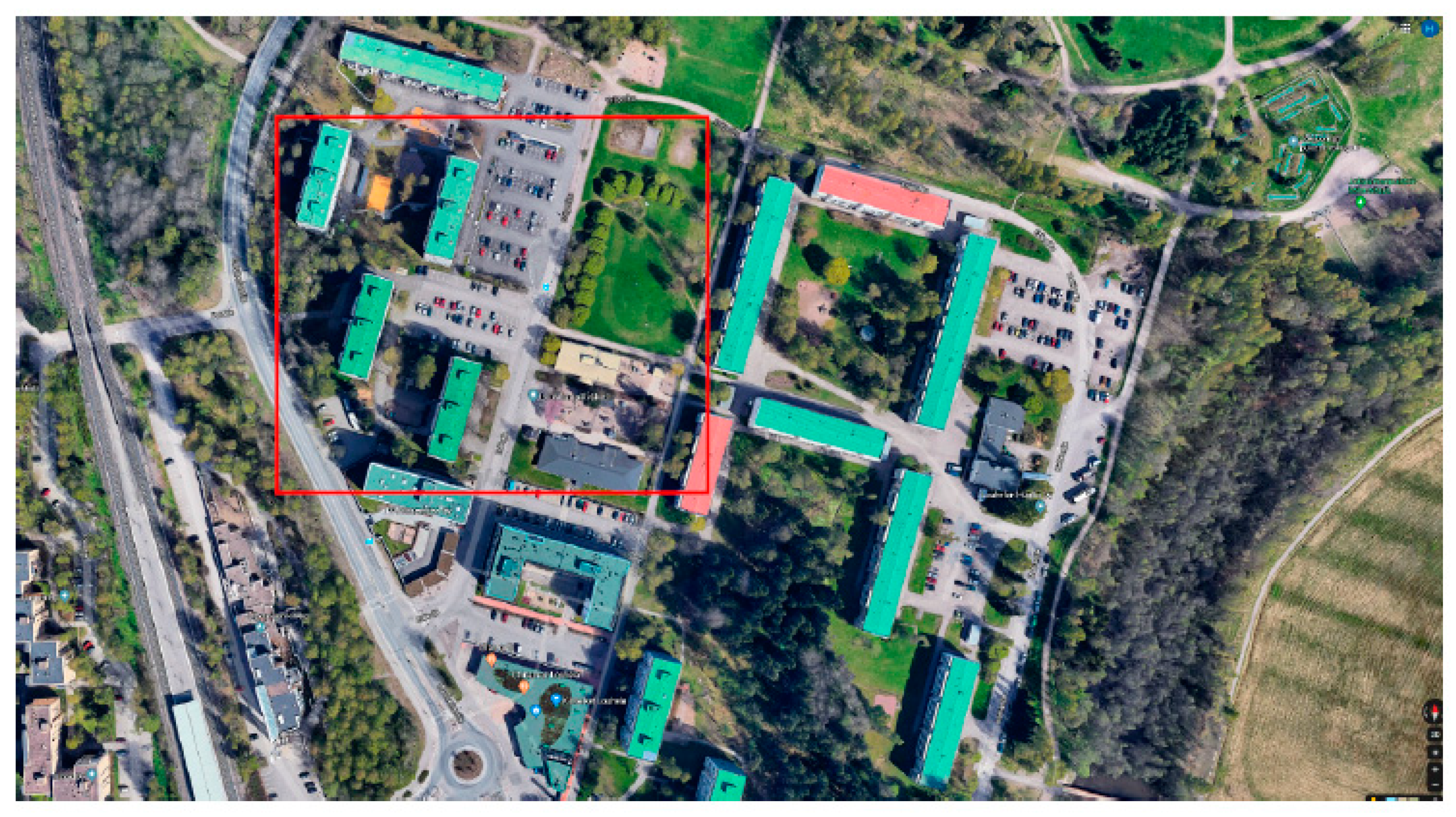
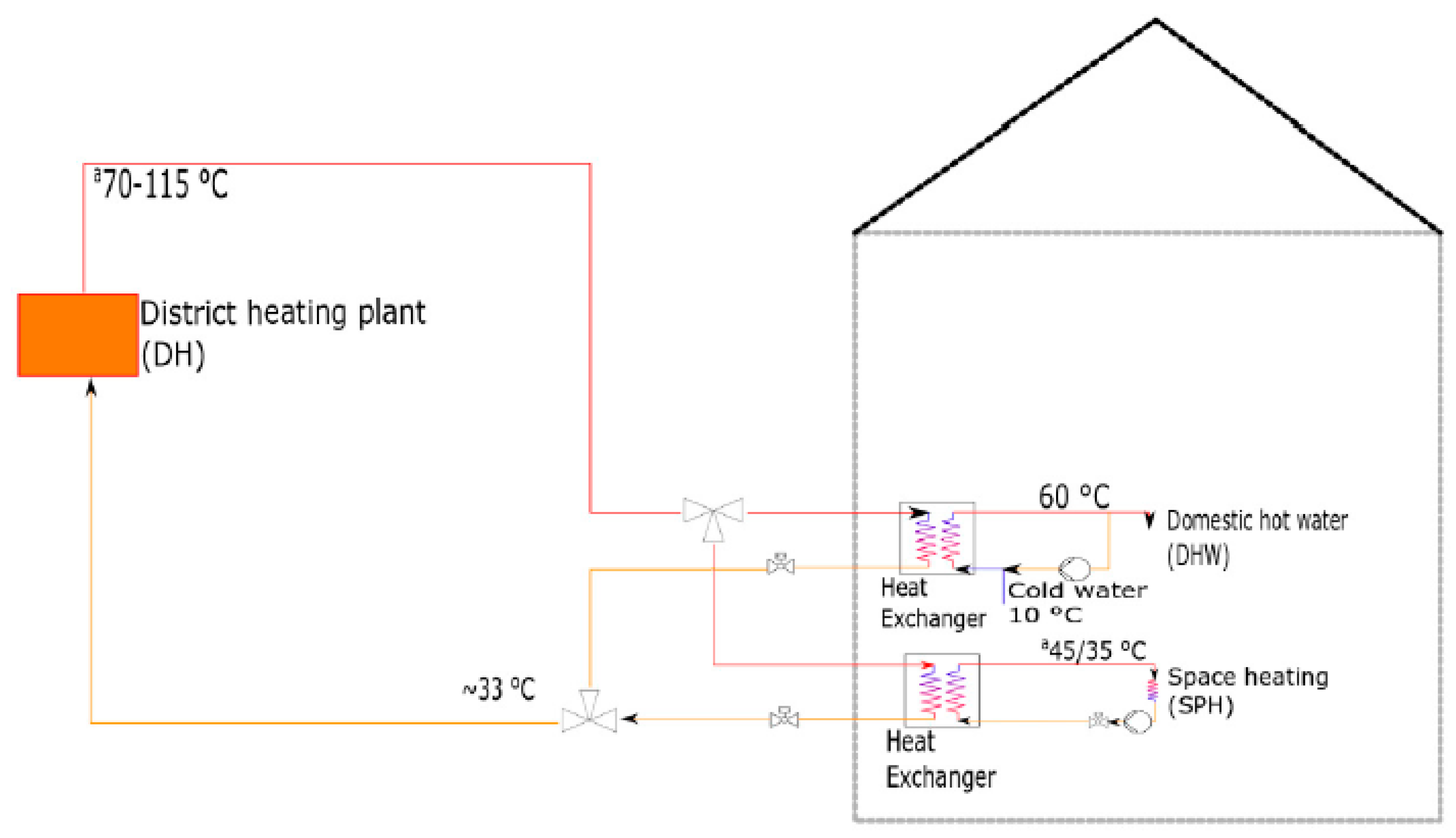


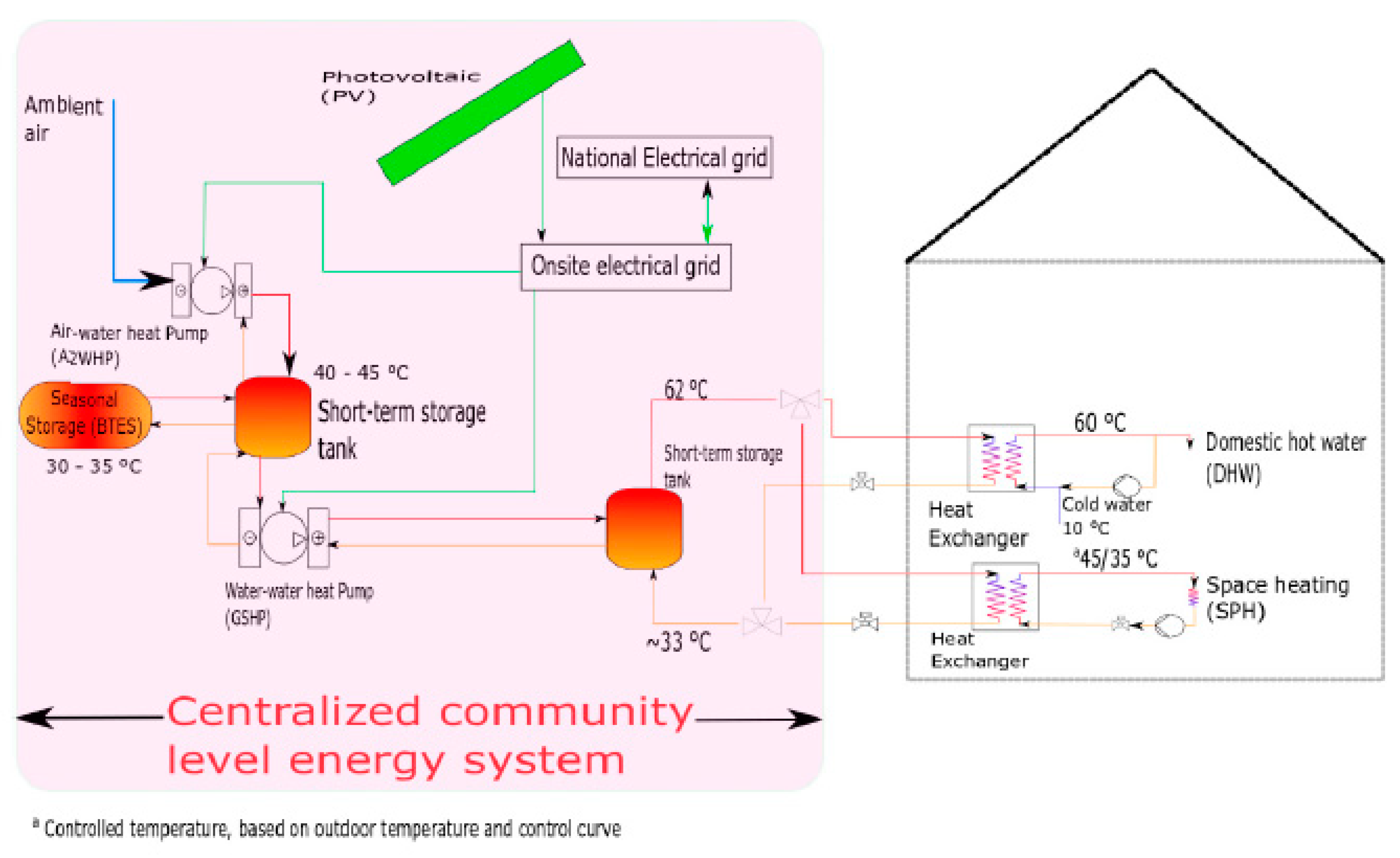



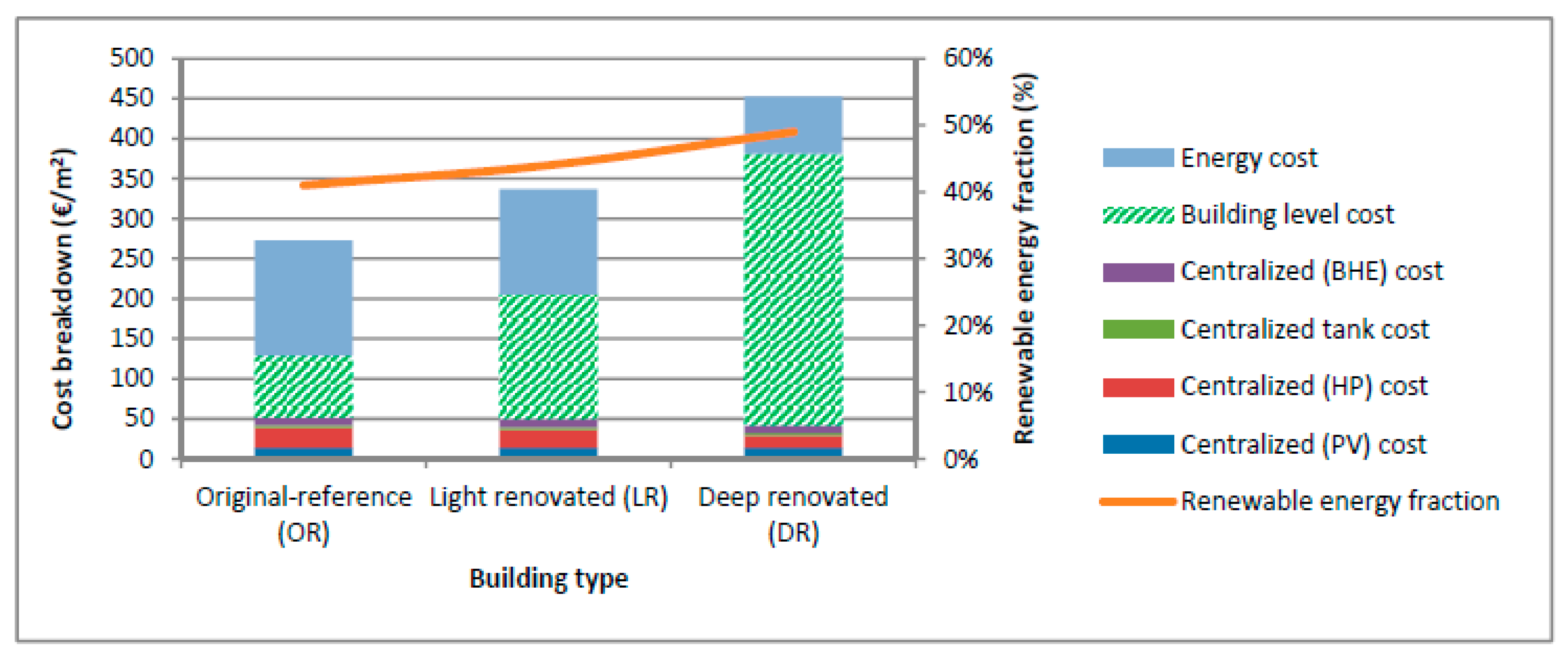
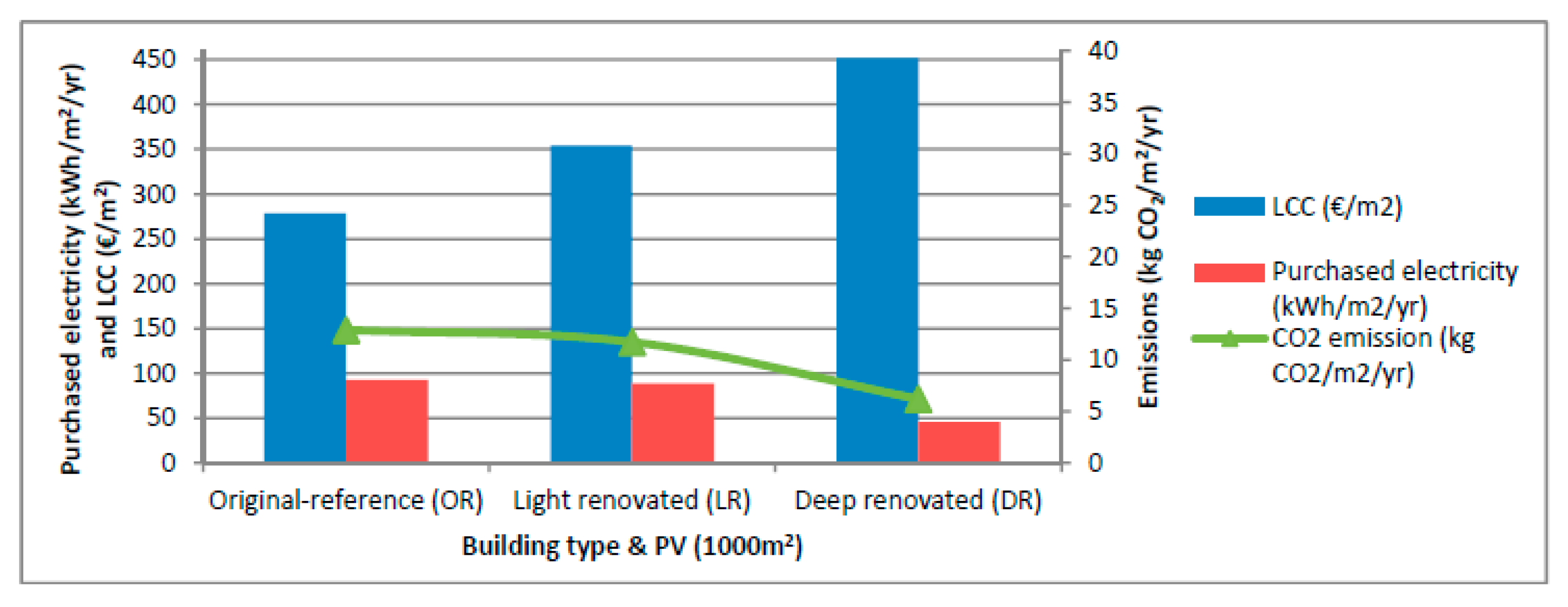

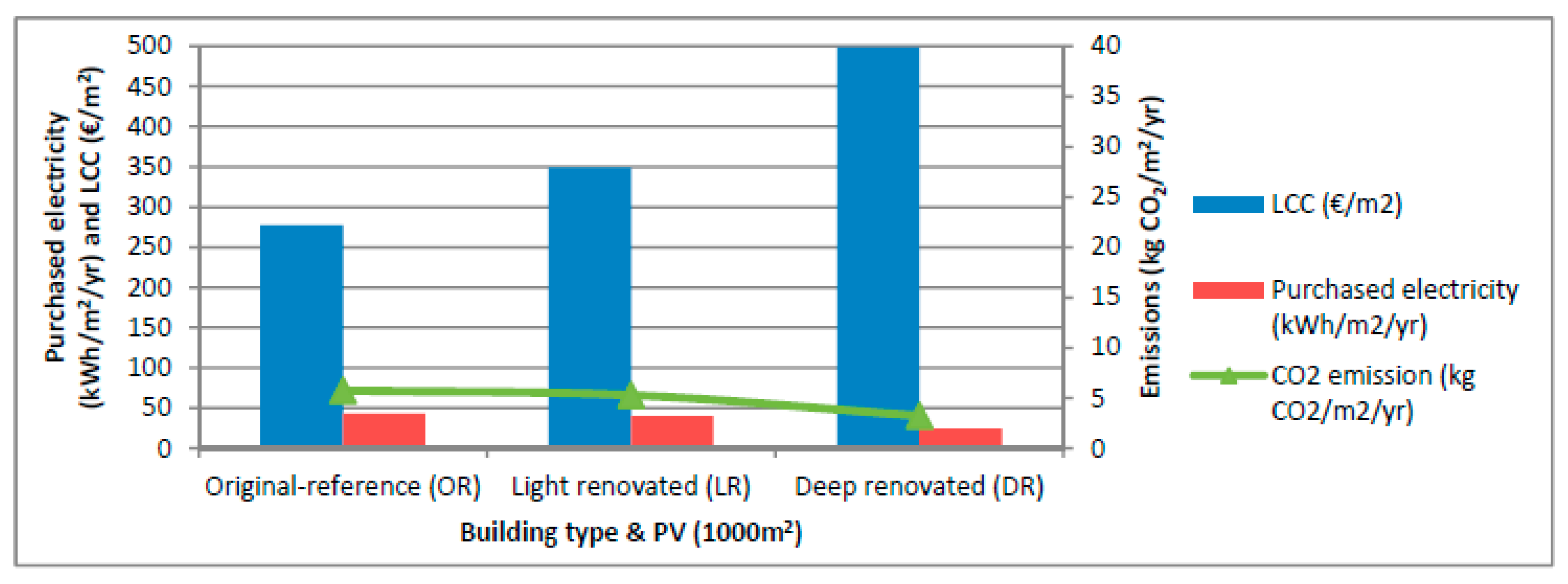

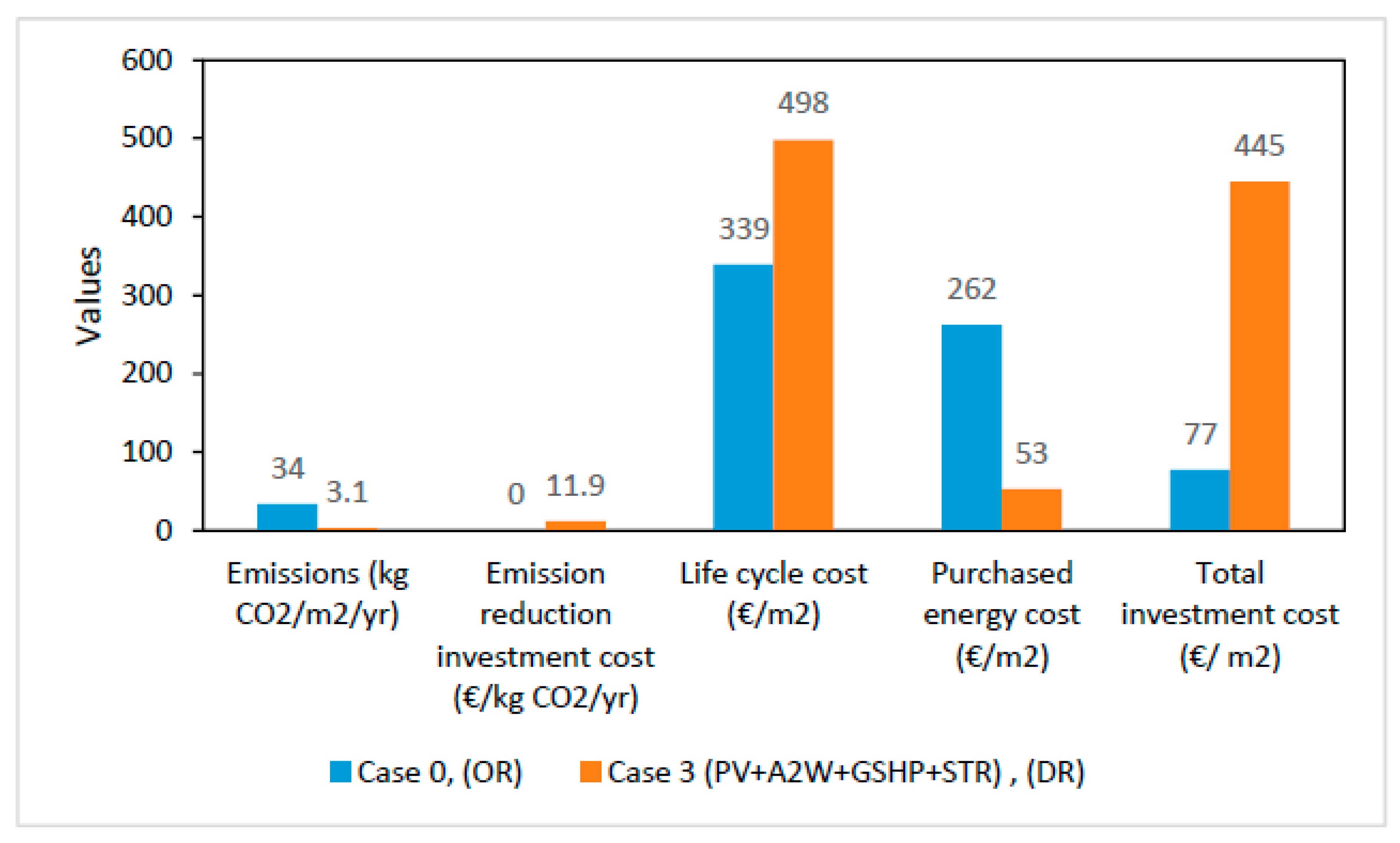
| Design Parameter | Value |
|---|---|
| External wall insulation (U-value) | 0.81 W/m2 K |
| Floor insulation (U-value) | 0.47 W/m2 K |
| Roof insulation (U-value) | 0.47 W/m2 K |
| Doors (U-value) | 2.2 W/m2 K |
| Windows | 1.7 W/m2 K |
| Total solar heat transmittance (g) | 0.71 |
| Direct solar transmittance (ST) | 0.64 |
| Air leakage rate n50 | 3.2 1/h |
| Air leakage rate q50 | 9.7 m3/h m2 |
| Ventilation | Mechanical exhaust |
| Heat recovery efficiency | 0% |
| Air exchange rate | 0.5 1/h |
| SFP | 1.5 kW/m3/s |
| Heated floor area/building | 4000 m2 |
| Window area | 464 m2 |
| Building Configuration | Space Heating Demand (SPH) (kWh/m2/yr) | Walls U-Value (W/m2 K) | Roof U-Value (W/m2 K) | Windows U-Value (W/m2 K) | Solar Thermal (m2) | Photovoltaic (m2) |
|---|---|---|---|---|---|---|
| Original reference (OR) | 129 | 0.81 | 0.47 | 1.7 | 0 | 0 |
| Light renovated (LR) | 113 | 0.81 | 0.08 | 0.7 | 55 | 30 |
| Deep renovated (DR) | 53 | 0.36 | 0.08 | 0.8 | 55 | 30 |
| Case Number | Design Variables | Range of the Values | Investment Cost | References and Valuation Year |
|---|---|---|---|---|
| 0 | Building level costs: | |||
| Building type heating demand | Original reference (OR) heat demand = 129 kWh/m2/yr | 77 €/m2 | [19], 2018 | |
| Light renovated (LR) heat demand = 113 kWh/m2/yr | 156 €/m2 | |||
| Deep renovated (DR) heat demand = 53 kWh/m2/yr | 339 €/m2 | |||
| 1 | Centralized level costs: | |||
| Monocrystalline PV capacity (m2) | 1000 | 230 €/PV m2 | [96], 2016 | |
| Short-term storage tank volume (m3) | 60 | 892 €/m3 | [97], 2016 | |
| Water-water heat pump (60 kWthermal/unit) | 12–20 (based on building type) | 325 €/kWthermal | [98], 2013 | |
| BTES aspect ratio | 1.5 | 33.5 €/m (drilling) | [54,98,99], 2016 | |
| BTES density (boreholes/m2) | 0.04 | |||
| 2 | Centralized level costs: | |||
| Monocrystalline PV capacity (m2) | 1000 | 230 €/PV m2 | [96], 2016 | |
| Short-term storage tank volume (m3) | 60 | 892 €/m3 | [97], 2016 | |
| Air-water heat pump (16 kWthermal/unit each) | 65–100 (based on building type) | 425 €/kWthermal | [89], 2017 | |
| 3 | Centralized level costs: | |||
| Monocrystalline PV capacity (m2) | 1000 | 230 €/PV m2 | [96], 2016 | |
| Short-term warm storage tank volume (m3) | 100 | 860 €/m3 | [97], 2016 | |
| Short-term hot storage tank volume (m3) | 100 | 860 €/m3 | ||
| Water-water heat pump (60 kWthermal/unit) | 5 | 325 €/kWthermal | [98], 2013 | |
| Air-water heat pump (16 kWthermal/unit each) | 50 | 425 €/kWthermal | [89], 2017 | |
| BTES aspect ratio | 1.5 | 33.5 €/m (drilling) + 3 €/m3(excavation for insulation) + 88 €/m3 (1.5 m insulation thickness) | ||
| BTES density (boreholes/m2) | 0.15 | [98,99], 2016 | ||
| BTES volume (m3) | 120,000 | |||
| Building Configuration | Emissions (kg CO2/m2/yr) | Emission Reduction (kg CO2/m2/yr) | Relative Reduction in Emissions (%) | LCC (€/m2) | Building Level Investment Cost (€/m2) | Centralized Energy System Investment Cost (€/m2) | Purchased Energy Cost (€/m2) | Total Investment Cost (€/m2) | Emission Reduction Investment Cost (€/kg CO2/yr) | Building Level Cost Ratio (%) | Centralized System Cost Ratio (%) | Purchased Energy Cost Ratio (%) |
|---|---|---|---|---|---|---|---|---|---|---|---|---|
| Case 0, (OR) | 34 | - | - | 339 | 77 | 0 | 262 | 77 | - | 23 | - | 77 |
| Case 1 (PV + GSHP), (OR) | 13.1 | 20.9 | 61 | 273 | 77 | 52 | 144 | 129 | 2.48 | 28 | 19 | 53 |
| Case 2 (PV + A2WHP-DH), (OR) | 12.9 | 21.1 | 62 | 278 | 77 | 60 | 141 | 137 | 2.84 | 28 | 21 | 51 |
| Case 3 (PV + A2W + GSHP + STR), (OR) | 5.7 | 28.3 | 83 | 277 | 77 | 106 | 94 | 183 | 3.74 | 28 | 38 | 34 |
| Building Configuration | Emissions (kg CO2/m2/yr) | Emission Reduction (kg CO2/m2/yr) | Relative Reduction in Emissions (%) | LCC (€/m2) | Building Level Investment Cost (€/m2) | Centralized Energy System Investment Cost (€/m2) | Purchased Energy Cost (€/m2) | Total Investment Cost (€/m2) | Emission Reduction Investment Cost (€/kg CO2/yr) | Building Level Cost Ratio (%) | Centralized System Cost Ratio (%) | Purchased Energy Cost Ratio (%) |
|---|---|---|---|---|---|---|---|---|---|---|---|---|
| Case 0, (OR) | 16 | 18 (from Case 0 + OR building) | 52 (from Case 0 + OR building) | 459 | 339 | 0 | 120 | 339 | - | 73 | - | 27 |
| Case 1 (PV + GSHP), (OR) | 6.7 | 9.3 (27.3) | 58 (80) | 452 | 339 | 42 | 71 | 381 | 4.51 | 75 | 9 | 16 |
| Case 2 (PV + A2WHP-DH), (OR) | 6.2 | 9.8 (27.8) | 61 (82) | 451 | 339 | 45 | 67 | 384 | 4.59 | 75 | 10 | 15 |
| Case 3 (PV + A2W + GSHP + STR), (OR) | 3.1 | 12.9 (30.9) | 80 (91) | 498 | 339 | 106 | 53 | 445 | 8.21 | 68 | 21 | 11 |
© 2020 by the authors. Licensee MDPI, Basel, Switzerland. This article is an open access article distributed under the terms and conditions of the Creative Commons Attribution (CC BY) license (http://creativecommons.org/licenses/by/4.0/).
Share and Cite
Rehman, H.u.; Hirvonen, J.; Jokisalo, J.; Kosonen, R.; Sirén, K. EU Emission Targets of 2050: Costs and CO2 Emissions Comparison of Three Different Solar and Heat Pump-Based Community-Level District Heating Systems in Nordic Conditions. Energies 2020, 13, 4167. https://doi.org/10.3390/en13164167
Rehman Hu, Hirvonen J, Jokisalo J, Kosonen R, Sirén K. EU Emission Targets of 2050: Costs and CO2 Emissions Comparison of Three Different Solar and Heat Pump-Based Community-Level District Heating Systems in Nordic Conditions. Energies. 2020; 13(16):4167. https://doi.org/10.3390/en13164167
Chicago/Turabian StyleRehman, Hassam ur, Janne Hirvonen, Juha Jokisalo, Risto Kosonen, and Kai Sirén. 2020. "EU Emission Targets of 2050: Costs and CO2 Emissions Comparison of Three Different Solar and Heat Pump-Based Community-Level District Heating Systems in Nordic Conditions" Energies 13, no. 16: 4167. https://doi.org/10.3390/en13164167
APA StyleRehman, H. u., Hirvonen, J., Jokisalo, J., Kosonen, R., & Sirén, K. (2020). EU Emission Targets of 2050: Costs and CO2 Emissions Comparison of Three Different Solar and Heat Pump-Based Community-Level District Heating Systems in Nordic Conditions. Energies, 13(16), 4167. https://doi.org/10.3390/en13164167






